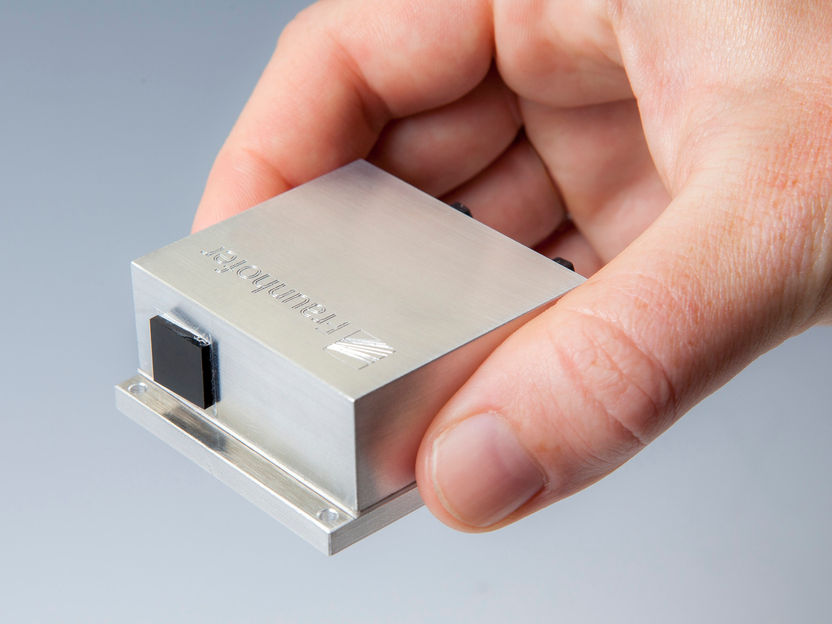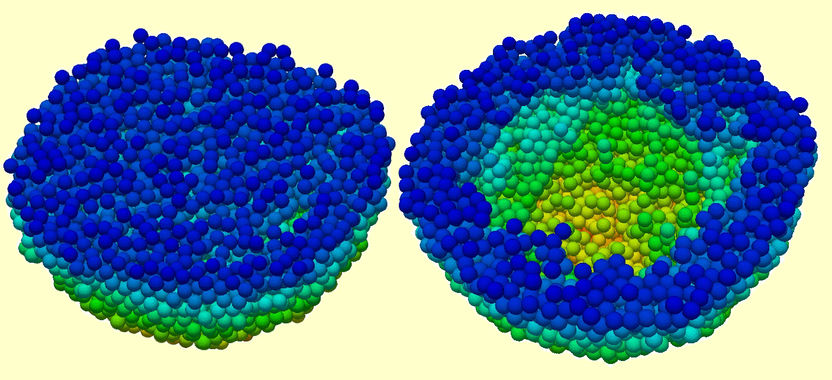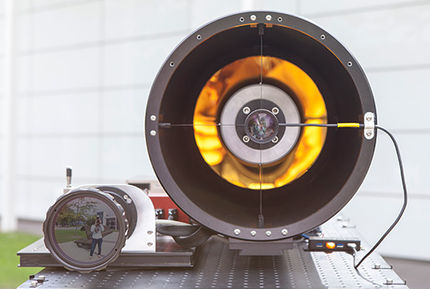On-site detection of hazardous substances
Together with partners from research and industry, Fraunhofer IAF has developed a hand-held scanner for hazardous substances within the EU project CHEQUERS. The sensor detects explosive, toxic and other dangerous substances in real time and will help emergency personnel with on-site detections at crime scenes, after accidents or terroristic attacks.

Fraunhofer IAF develops extremely compact and robust quantum cascade laser modules for a variety of spectroscopic applications.
© Fraunhofer IAF
Police forces encounter a suspicious room during a house search – a room that could be anything: a drug or explosive laboratory or just a fake. In order to react immediately, they need to know which chemical substances they are confronted with. Usually, the analysis would be time consuming and would involve taking a sample and sending it to an external laboratory. Portable, eye-safe scanners with the ability to identify numerous chemicals fast and remotely up to a distance of 1 m do not exist to date.
Within the EU project CHEQUERS, the Fraunhofer Institute for Applied Solid State Physics IAF and its partners have jointly developed a hand-held scanner for the remote detection of explosives and hazardous substances. »Our hazardous substance scanner covers a large spectral range in no time, provides precise results and can even be used by untrained personnel. This is extremely useful at crime scenes, after terroristic attacks or after accidents in industrial plants in which chemicals spread in an uncontrolled way. Rescue forces can react immediately to the threat«, explains Dr. Stefan Hugger, project manager and scientist at Fraunhofer IAF.
Fast, precise and hand-held
The consortium of CHEQUERS faced the technical challenge to realize a hand-held system for remote detections of hazardous substances from a safe distance and with fast reaction time. The result is a measuring device based on infrared backscattering spectroscopy. The research team combined very fast widely tunable quantum cascade lasers with adjusted transmission and receiver optics, fast IR detectors and a fitting control and detection software.
The research took place within the project »Compact high performance laser sensors«, CHEQUERS for short (www.chequers.eu). Since 2015, Fraunhofer IAF collaborated with the Fraunhofer Institutes IPMS and CAP, the Federal Criminal Police Office, as well as the companies Vigo Systems, M Squared Lasers and Modus Research and Innovation, in order to develop a hand-held scanner for hazardous substances. CHEQUERS was funded by the European Union within the program Horizon 2020. On April 25, 2019, the project partners me to successfully close the project in Brussels.
Miniaturized quantum cascade laser
Portable sensors for remote spectroscopic detections require especially compact and fast tunable laser sources. »Such devices need to compensate the inevitable movements of the hand and still be able to detect a conclusive spectrum within a short amount of time. Together with Fraunhofer IPMS, we have developed a miniaturized quantum cascade laser with an external resonator that is able to scan the whole spectral range of the QC laser chip within just a millisecond«, explains Hugger, who represented Fraunhofer IAF at the final meeting. The measuring principle is based on selective spectral lighting of the target in the wavelength range of 1000 – 1300 cm-1. The chemical substance is identified based on the intensity of the backscattered light and the illumination wavelength. The so-called spectral fingerprint is matched with the integrated database that contains a large amount of safety-relevant substances, and thus the substance can be identified.
The hand-held demonstrator succeeded at a series of test measurements conducted by the Federal Criminal Police Office in cooperation with Fraunhofer IAF in early 2019. »During the test measurements, the scanner for hazardous substances was able to detect many explosives and their precursor materials, and has thus proven that the technology works. The next step is to increase the robustness of the measuring system to make it ready for daily use«, closes Hugger.
Other news from the department research and development

Get the chemical industry in your inbox
By submitting this form you agree that LUMITOS AG will send you the newsletter(s) selected above by email. Your data will not be passed on to third parties. Your data will be stored and processed in accordance with our data protection regulations. LUMITOS may contact you by email for the purpose of advertising or market and opinion surveys. You can revoke your consent at any time without giving reasons to LUMITOS AG, Ernst-Augustin-Str. 2, 12489 Berlin, Germany or by e-mail at revoke@lumitos.com with effect for the future. In addition, each email contains a link to unsubscribe from the corresponding newsletter.
Most read news
More news from our other portals
See the theme worlds for related content
Topic World Spectroscopy
Investigation with spectroscopy gives us unique insights into the composition and structure of materials. From UV-Vis spectroscopy to infrared and Raman spectroscopy to fluorescence and atomic absorption spectroscopy, spectroscopy offers us a wide range of analytical techniques to precisely characterize substances. Immerse yourself in the fascinating world of spectroscopy!

Topic World Spectroscopy
Investigation with spectroscopy gives us unique insights into the composition and structure of materials. From UV-Vis spectroscopy to infrared and Raman spectroscopy to fluorescence and atomic absorption spectroscopy, spectroscopy offers us a wide range of analytical techniques to precisely characterize substances. Immerse yourself in the fascinating world of spectroscopy!
Topic world Sensor technology
Sensor technology has revolutionized the chemical industry by providing accurate, timely and reliable data across a wide range of processes. From monitoring critical parameters in production lines to early detection of potential malfunctions or hazards, sensors are the silent sentinels that ensure quality, efficiency and safety.

Topic world Sensor technology
Sensor technology has revolutionized the chemical industry by providing accurate, timely and reliable data across a wide range of processes. From monitoring critical parameters in production lines to early detection of potential malfunctions or hazards, sensors are the silent sentinels that ensure quality, efficiency and safety.
Last viewed contents
Software for the discovery of new crystal structures
Covestro generates strong volume growth in a continuing challenging environment - New circular economy program launched
Arkema Upgrades its Price Increases for High Performance Polyamides
20-hydroxyecdysone
A new way to make sheets of graphene
Pharmacy

Green hydrogen: A cage structured material transforms into a performant catalyst - Very interesting class of materials for electrocatalysts discovered?

Watching lithium in real time could improve performance of EV battery materials - Researchers tracked the movement of lithium ions inside a promising new battery material

Spray drying the precision particle under the virtual magnifying glass
REACH is the dominant driver for substitution - more action is needed
Category:Materials_science_institutes





























































